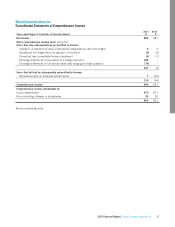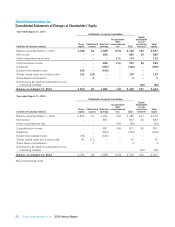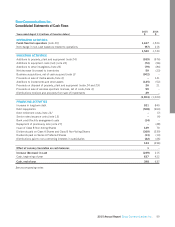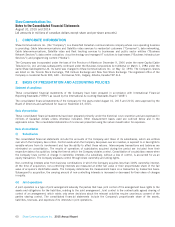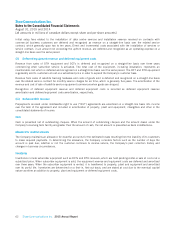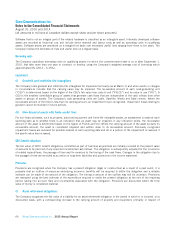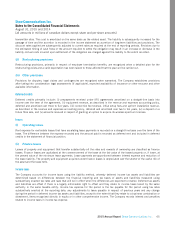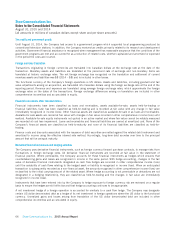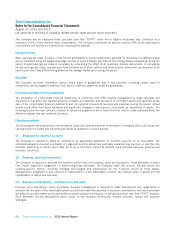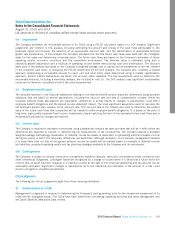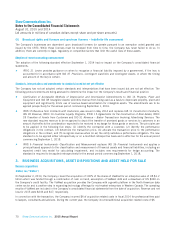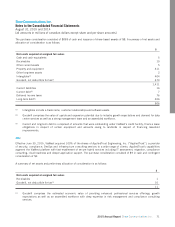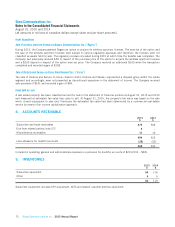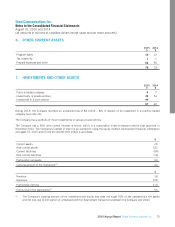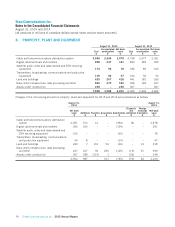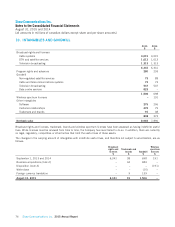Shaw 2015 Annual Report Download - page 68
Download and view the complete annual report
Please find page 68 of the 2015 Shaw annual report below. You can navigate through the pages in the report by either clicking on the pages listed below, or by using the keyword search tool below to find specific information within the annual report.Shaw Communications Inc.
Notes to the Consolidated Financial Statements
August 31, 2015 and 2014
[all amounts in millions of canadian dollars except share and per share amounts]
Tax credits and government grants
Until August 31, 2014, the Company had access to a government program which supported local programming produced by
conventional television stations. In addition, the Company receives tax credits primarily related to its research and development
activities. Government financial assistance is recognized when management has reasonable assurance that the conditions of the
government programs are met and accounted for as a reduction of related costs, whether capitalized and amortized or expensed
in the period the costs are incurred.
Foreign currency translation
Transactions originating in foreign currencies are translated into Canadian dollars at the exchange rate at the date of the
transaction. Monetary assets and liabilities are translated at the period-end rate of exchange and non-monetary items are
translated at historic exchange rates. The net foreign exchange loss recognized on the translation and settlement of current
monetary assets and liabilities was $8 (2014 – $8) and is included in other losses.
The functional currency of the Company’s foreign operations is US dollars. Assets and liabilities, including goodwill and fair
value adjustments arising on acquisition, are translated into Canadian dollars using the foreign exchange rate at the end of the
reporting period. Revenue and expenses are translated using average foreign exchange rates, which approximate the foreign
exchange rates on the dates of the transactions. Foreign exchange differences arising on translation are included in other
comprehensive income/loss and accumulated in equity.
Financial instruments other than derivatives
Financial instruments have been classified as loans and receivables, assets available-for-sale, assets held-for-trading or
financial liabilities. Cash has been classified as held-for-trading and is recorded at fair value with any change in fair value
immediately recognized in income (loss). Other financial assets are classified as available-for-sale or as loans and receivables.
Available-for-sale assets are carried at fair value with changes in fair value recorded in other comprehensive income (loss) until
realized. Available-for-sale equity instruments not quoted in an active market and where fair value cannot be reliably measured
are recorded at cost less impairment. Loans and receivables and financial liabilities are carried at amortized cost. None of the
Company’s financial assets are classified as held-to-maturity and none of its financial liabilities are classified as held-for-
trading.
Finance costs and discounts associated with the issuance of debt securities are netted against the related debt instrument and
amortized to income using the effective interest rate method. Accordingly, long-term debt accretes over time to the principal
amount that will be owing at maturity.
Derivative financial instruments and hedging activities
The Company uses derivative financial instruments, such as foreign currency forward purchase contracts, to manage risks from
fluctuations in foreign exchange rates. All derivative financial instruments are recorded at fair value in the statement of
financial position. Where permissible, the Company accounts for these financial instruments as hedges which ensures that
counterbalancing gains and losses are recognized in income in the same period. With hedge accounting, changes in the fair
value of derivative financial instruments designated as cash flow hedges are recorded in other comprehensive income (loss)
until the variability of cash flows relating to the hedged asset or liability is recognized in income (loss). When an anticipated
transaction is subsequently recorded as a non-financial asset, the amounts recognized in other comprehensive income (loss) are
reclassified to the initial carrying amount of the related asset. Where hedge accounting is not permissible or derivatives are not
designated in a hedging relationship, they are classified as held-for-trading and the changes in fair value are immediately
recognized in income (loss).
Instruments that have been entered into by the Company to hedge exposure to foreign currency risk are reviewed on a regular
basis to ensure the hedges are still effective and that hedge accounting continues to be appropriate.
A net investment hedge of a foreign operation is accounted for similarly to a cash flow hedge. The Company may designate
certain US dollar denominated debt as a hedge of its net investment in foreign operations where the US dollar is the functional
currency. Unrealized gains and losses arising from translation of the US dollar denominated debt are included in other
comprehensive income/loss and accumulated in equity.
66 Shaw Communications Inc. 2015 Annual Report



